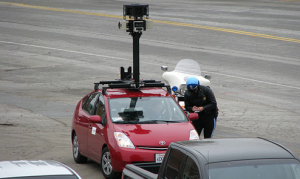How to keep your Wi-Fi location out of Google

This summer it was revealed that Google Street View cars, besides taking photos of your neighborhood, were also collecting the street addresses, Wi-Fi service set identifier (SSID), and the unique Media Access Control (MAC) identification information for computers, Wi-Fi access points (AP)s, and routers. Worse still, Google was, apparently by accident, also grabbing unencrypted passwords and e-mails. Yack!
While Google quickly backed off grabbing people's personal data, the company's Google Street View cars are continuing to pick up Wi-Fi access points and routers' unique MACs, SSIDs, and physical addresses.
Google uses this information to improve its Google Map and other location-based services, but what if you don't want to contribute to this effort? Until recently, you were stuck.
Now, Google will let you opt-out. Frankly, I think it would be a lot better if they only recorded your Wi-Fi equipment's location if you opted in, but it is what it is.
Here's how you do it. The key is you have to change the SSID of your Wi-Fi access point so that it ends with "_nomap". For example, if your SSID is "catdog" you would need to change it to "catdog_nomap".
Here are instructions on some of the most common Wi-Fi AP brands.
On many access points, you can access its controls by which you can change its SSID using the following steps:
First, I need to go to my AP address from a Web browser. In my case, that was 192.168.0.130. More common AP addresses are 192.168.0.1 and 192.168.1.1. Once there, I needed to login to my system. If you're still using your AP's company provide default login and password, once you're in, take this opportunity to change it. Until you do, anyone who knows the device defaults can take over your AP.
Once in my Netgear device, I needed to Wireless Settings. Then, to set it up so that any wandering Google Street View car won't collect its location, I changed its SSID from Gith-5 to Gith-5_nomap. Google hopes that since "this method of opt out can also be seen by other location service providers, and we hope the industry will respect the "_nomap" tag." Then, the next time a device with a "reliable channel" tries to use your AP's information to fix its location, Google will take note that you no longer want to be in their databases and remove your devices' data.
And, what's a "reliable channel?" According to Google, it's a Wi-Fi device, like an Android phone that tries to use your AP to fix its location. So, for example, to get your home or office Wi-Fi off Google's location service in a hurry, just use Google Maps' My Location feature on a Wi-Fi enabled tablet or smartphone, and Google will note the change in your SSID and take your equipment off its maps.
That sounds good, but besides putting the burden on you to opt out of their system, Google's solution introduces another minor security/privacy problem. You see some people don't want to broadcast that they're providing any Wi-Fi services at all, so they don't broadcast any SSID.
Now, yes, finding an "invisible" SSID is trivial. Most Wi-Fi network utilities like inSSIDer, Kismet, and NetStumbler can do in seconds. But, many people still don't broadcast SSID so they can avoid would-be casual Wi-Fi users. With the Google "fix" though you have to use a SSID.
Don't think, by the by, that you've escaped Google's Argus gaze if you haven't been using an SSID. It's the MAC, which all networked devices have, that Google uses to uniquely identify and locate your AP or router.
Personally, I'm not going to bother to change my Wi-Fi APs' SSIDs. It's too much trouble for too little value. But, if you want to hide from Google, well, now you know how. Good luck.
Related Stories:
Google offers Street View opt-out for Wi-Fi mapping; Unethical snooping, yet we must opt-out?
Google's mistake leads to a lot of collected Wi-Fi payload data via Street View
Google admits Street View cars collected e-mails, passwords
